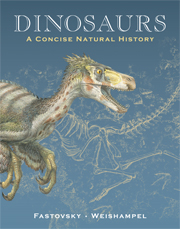Book contents
- Frontmatter
- Contents
- Why a natural history of dinosaurs?
- Dedication
- Part I Reaching back in time
- 1 To catch a dinosaur
- 2 Dinosaur days
- 3 Who's related to whom – and how do we know?
- 4 Who are the dinosaurs?
- Part II Ornithischia: armored, horned, and duck-billed dinosaurs
- Part III Saurischia: meat, might, and magnitude
- Part IV Endothermy, endemism, and extinction
- Glossary
- Figure credits
- Index of subjects
- Index of genera
2 - Dinosaur days
- Frontmatter
- Contents
- Why a natural history of dinosaurs?
- Dedication
- Part I Reaching back in time
- 1 To catch a dinosaur
- 2 Dinosaur days
- 3 Who's related to whom – and how do we know?
- 4 Who are the dinosaurs?
- Part II Ornithischia: armored, horned, and duck-billed dinosaurs
- Part III Saurischia: meat, might, and magnitude
- Part IV Endothermy, endemism, and extinction
- Glossary
- Figure credits
- Index of subjects
- Index of genera
Summary
Chapter objectives
Introducing geological time and stratigraphy
Learning about continental drift during the time of the dinosaurs
Learning about ancient climates during the time of the dinosaurs
When did dinosaurs live and how do we know?
Fossils, including dinosaur remains, are found in layers of rock, commonly called strata. The field of stratigraphy is the geological specialty that tells us how old or young particular strata are; thus, stratigraphy is a means of learning the age of dinosaur fossils. Stratigraphy is divided into chronostratigraphy or time stratigraphy (chronos – time), lithostratigraphy or rock stratigraphy (lithos – rock), and biostratigraphy or stratigraphy as indicated by the presence of fossils (bios – organisms).
Chronostratigraphy
Geologists generally signify time in two ways: in numbers of years before present, and by reference to blocks of time with special names. For example, we say that the Earth was formed 4.6 billion years before present, meaning that it was formed 4.6 billion years ago and is thus 4.6 billion years old. Unfortunately, determining the precise age in years of a particular rock or fossil is not always easy, or even possible. For this reason, geologists have divided time into intervals of varying lengths, and rocks and fossils can be referred to these intervals, depending upon how exactly the age of the rock or fossil can be estimated.
- Type
- Chapter
- Information
- DinosaursA Concise Natural History, pp. 18 - 31Publisher: Cambridge University PressPrint publication year: 2009

